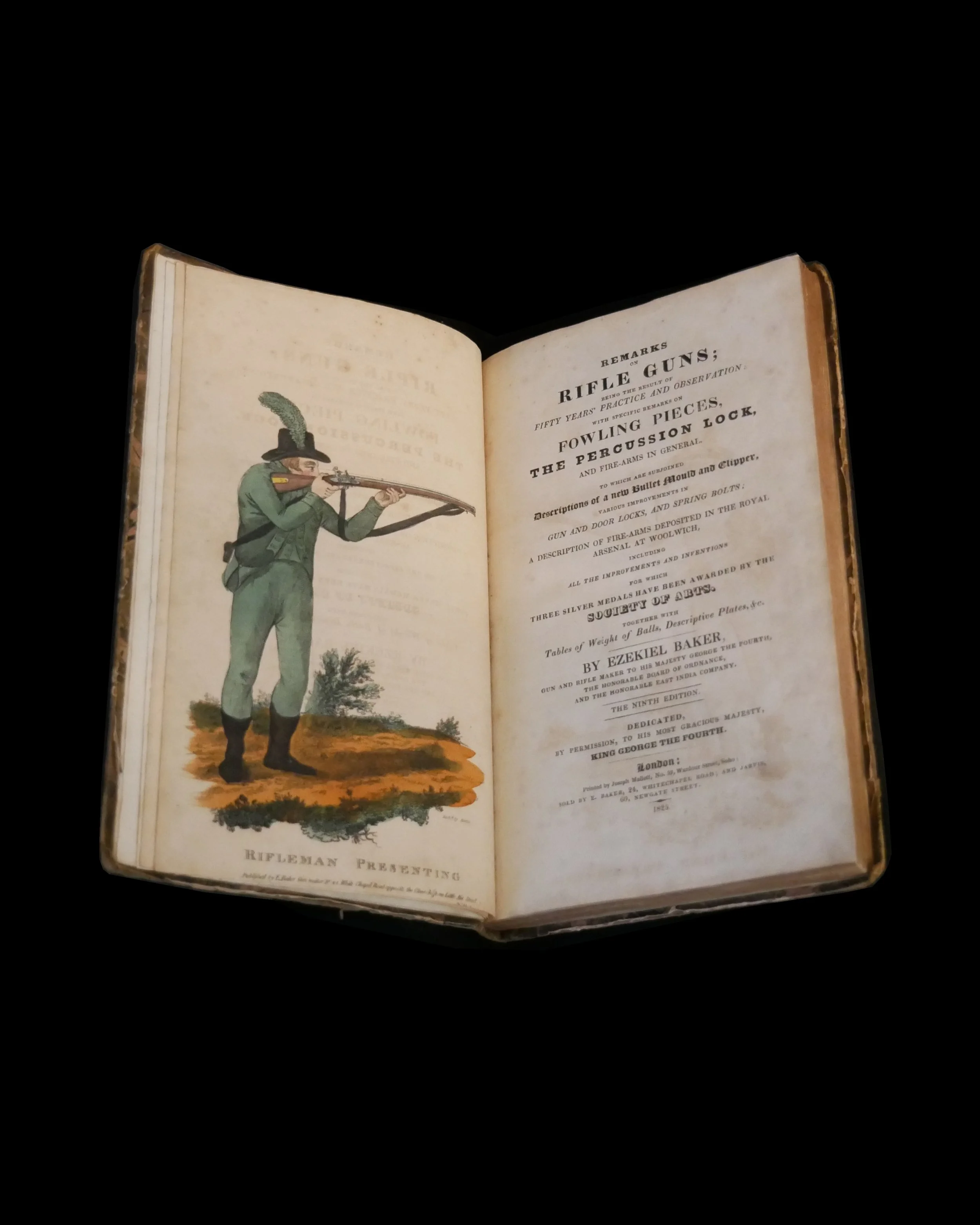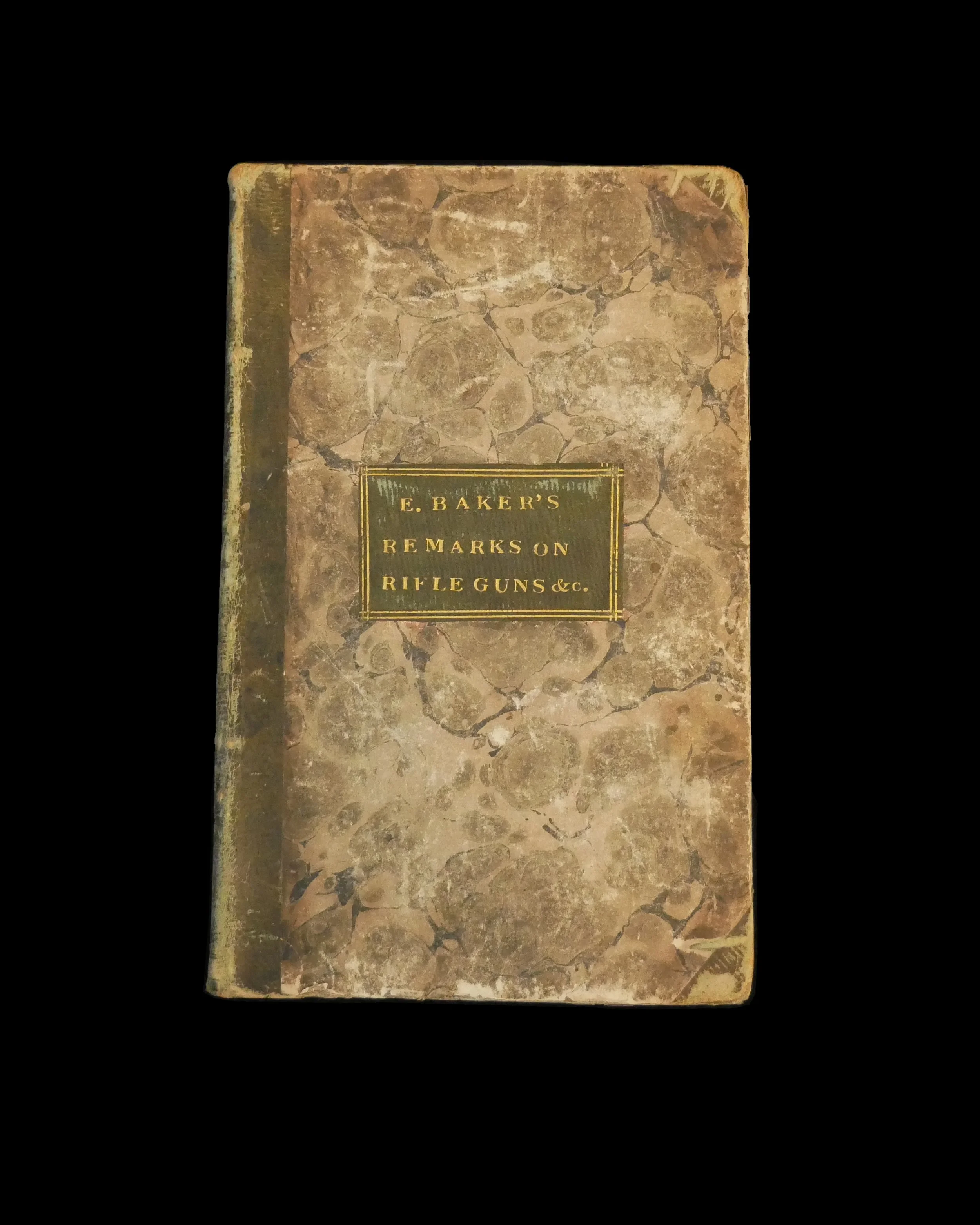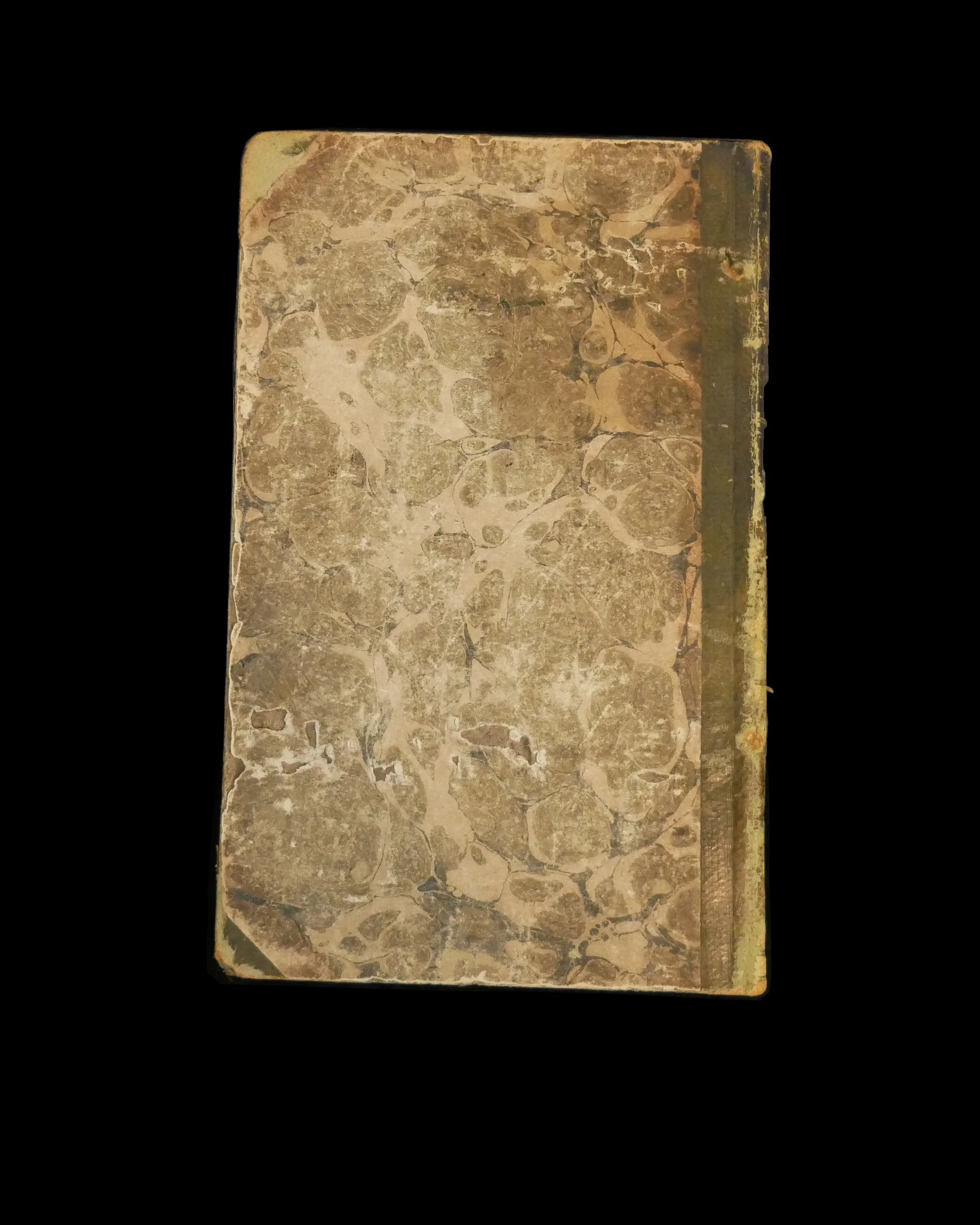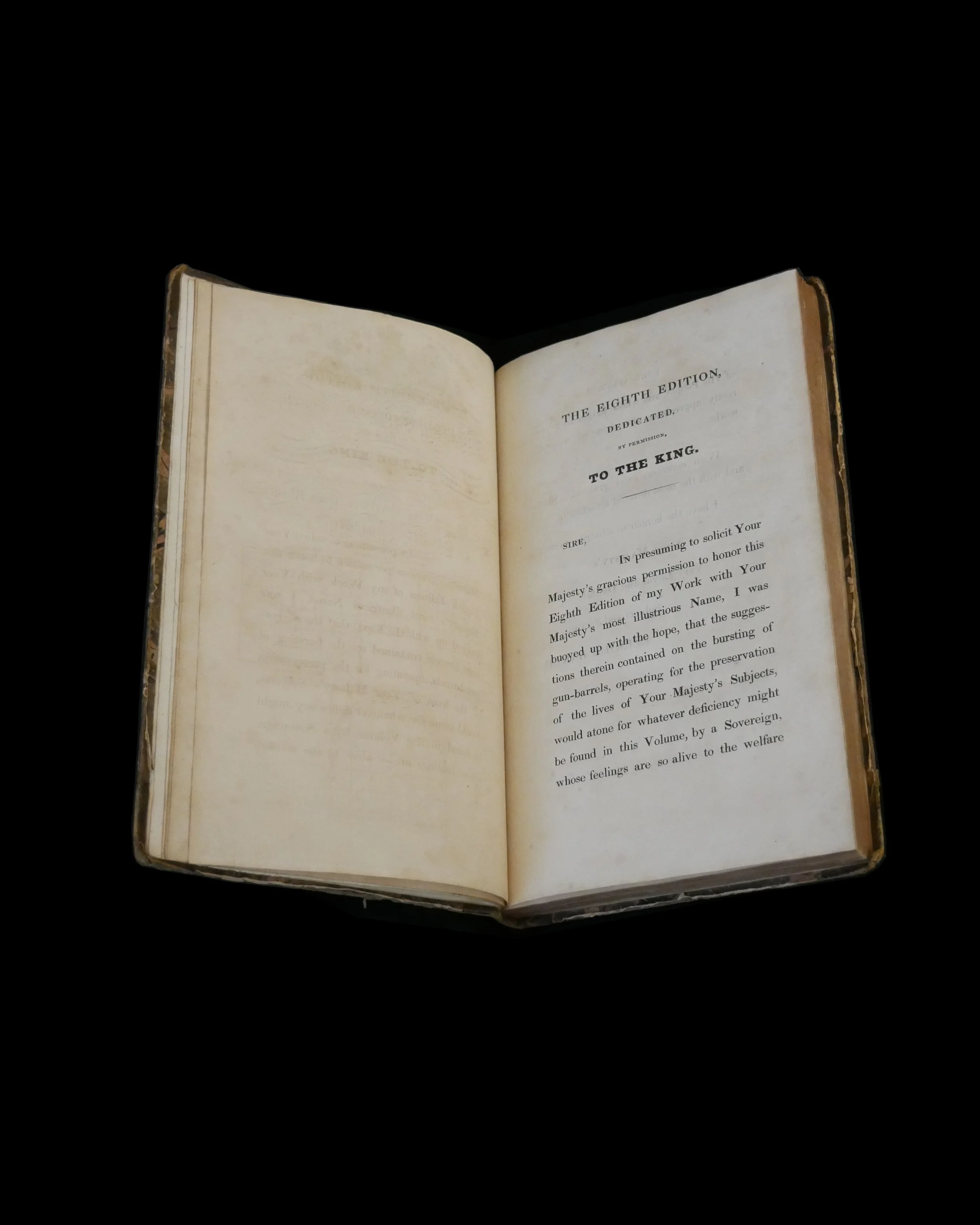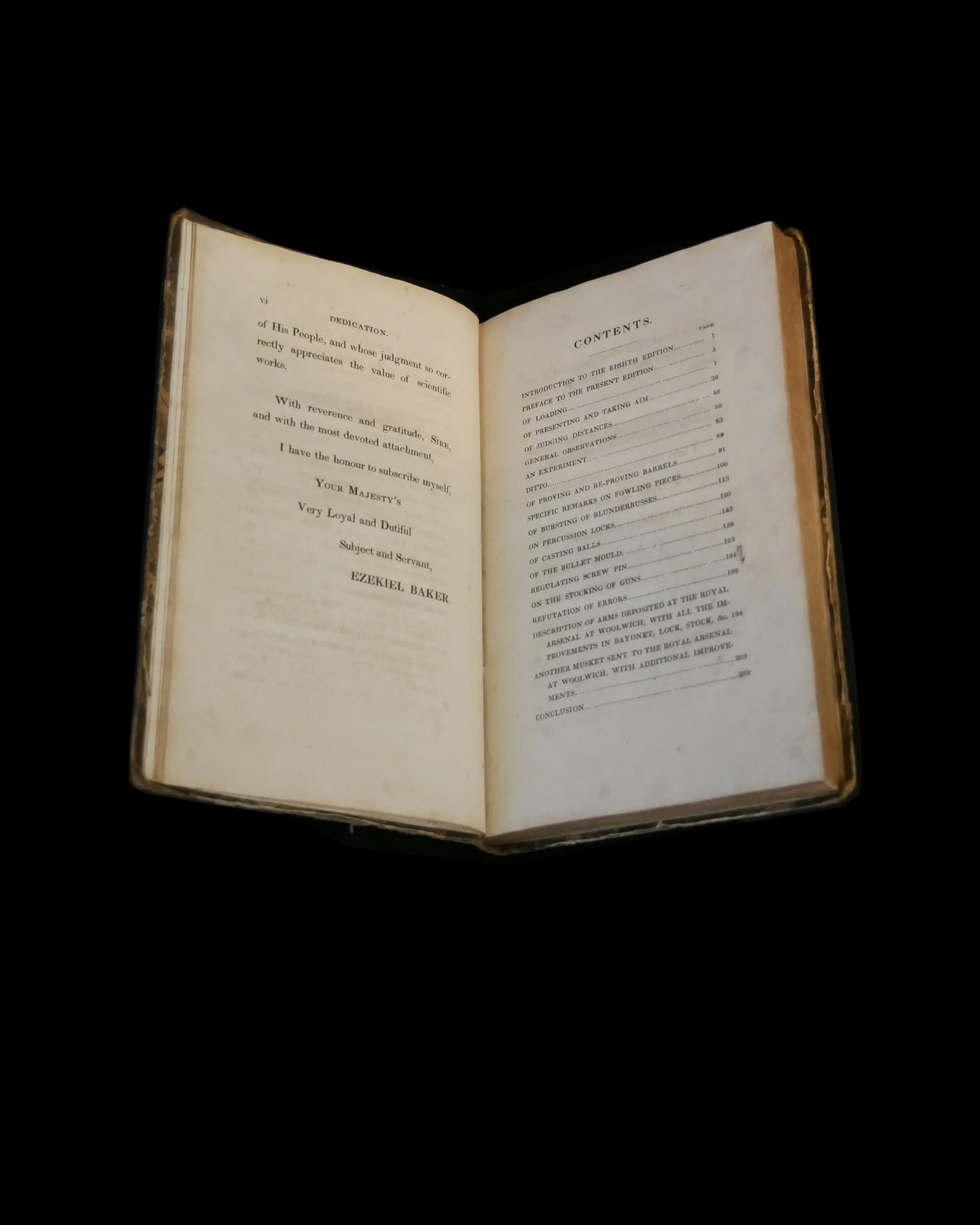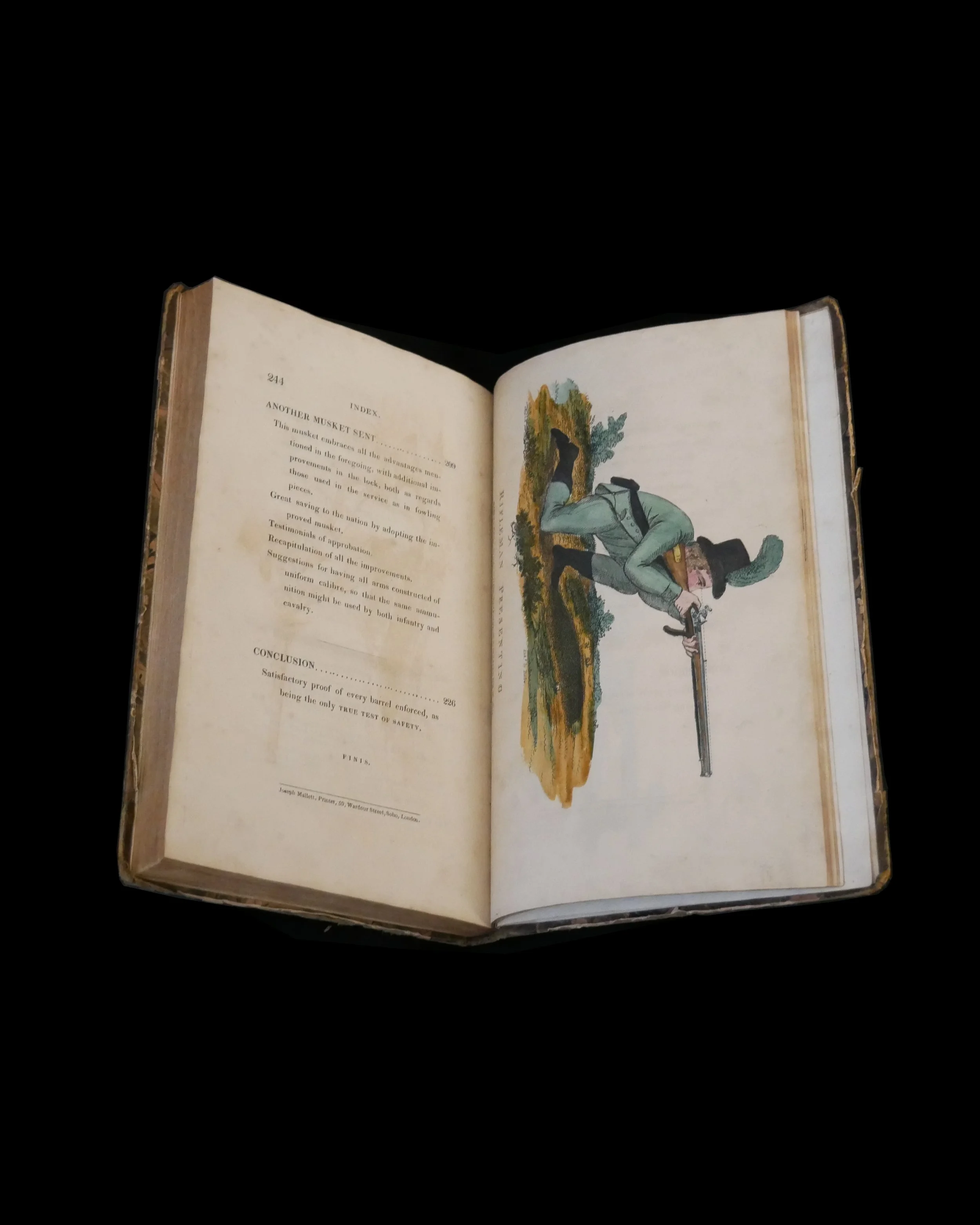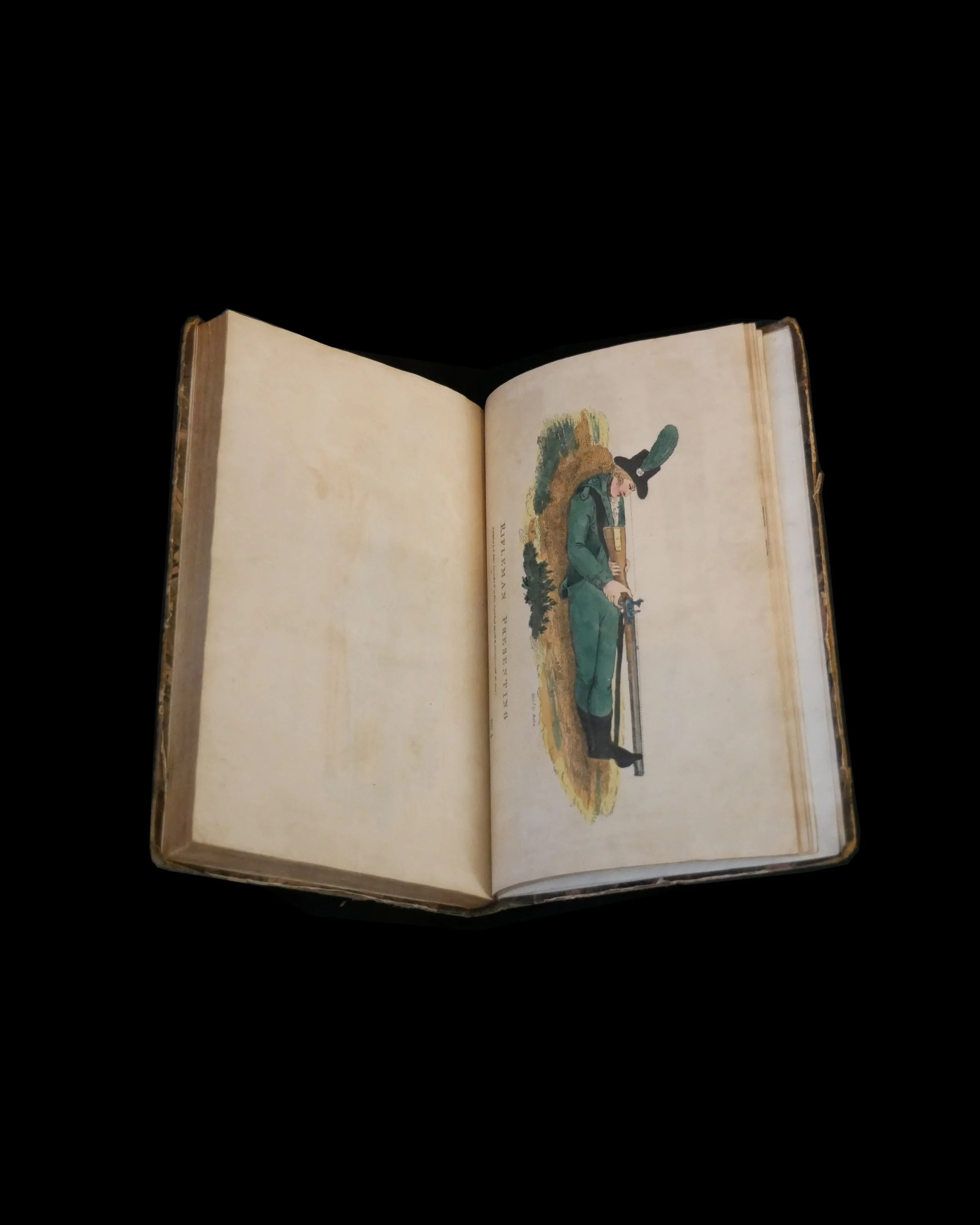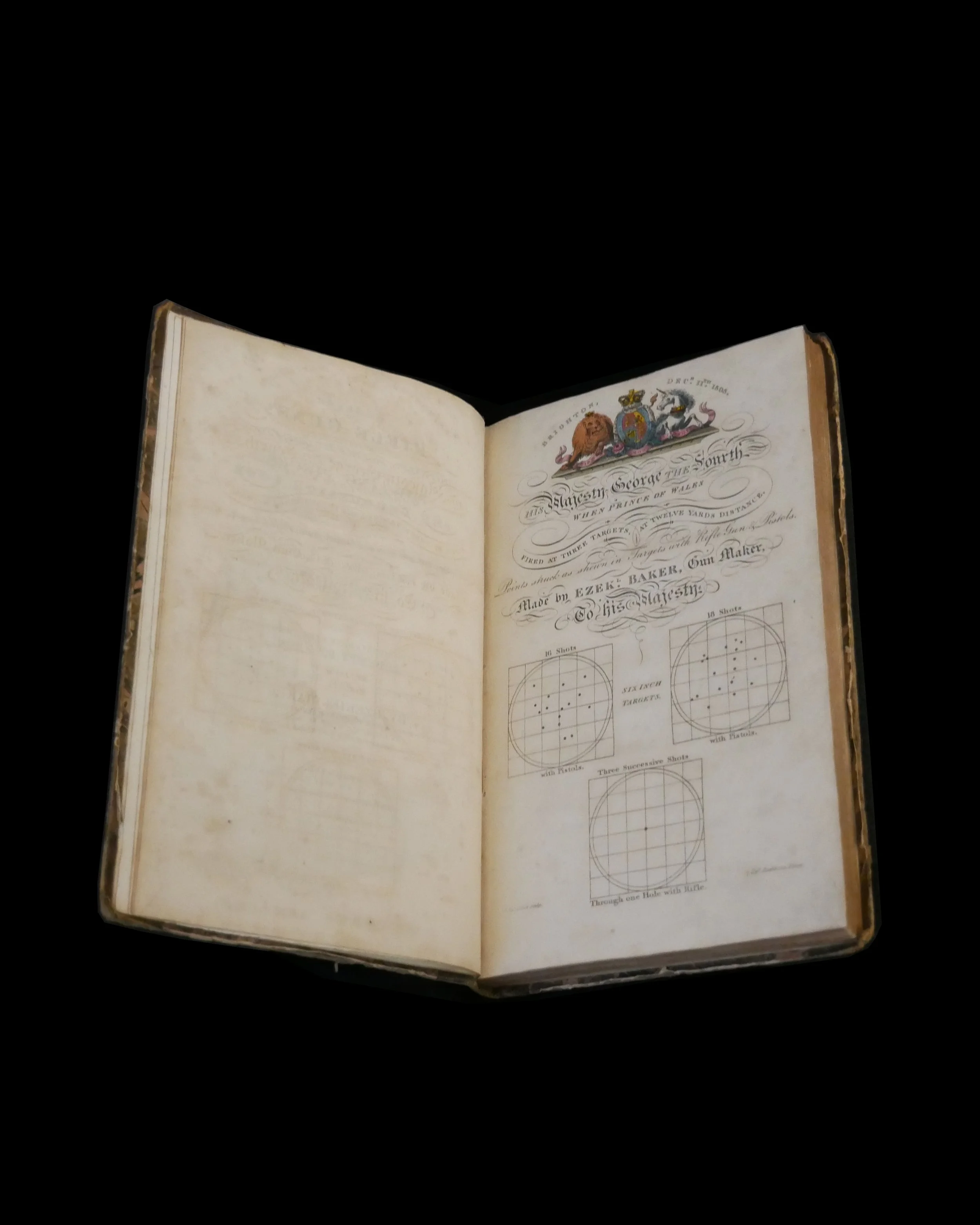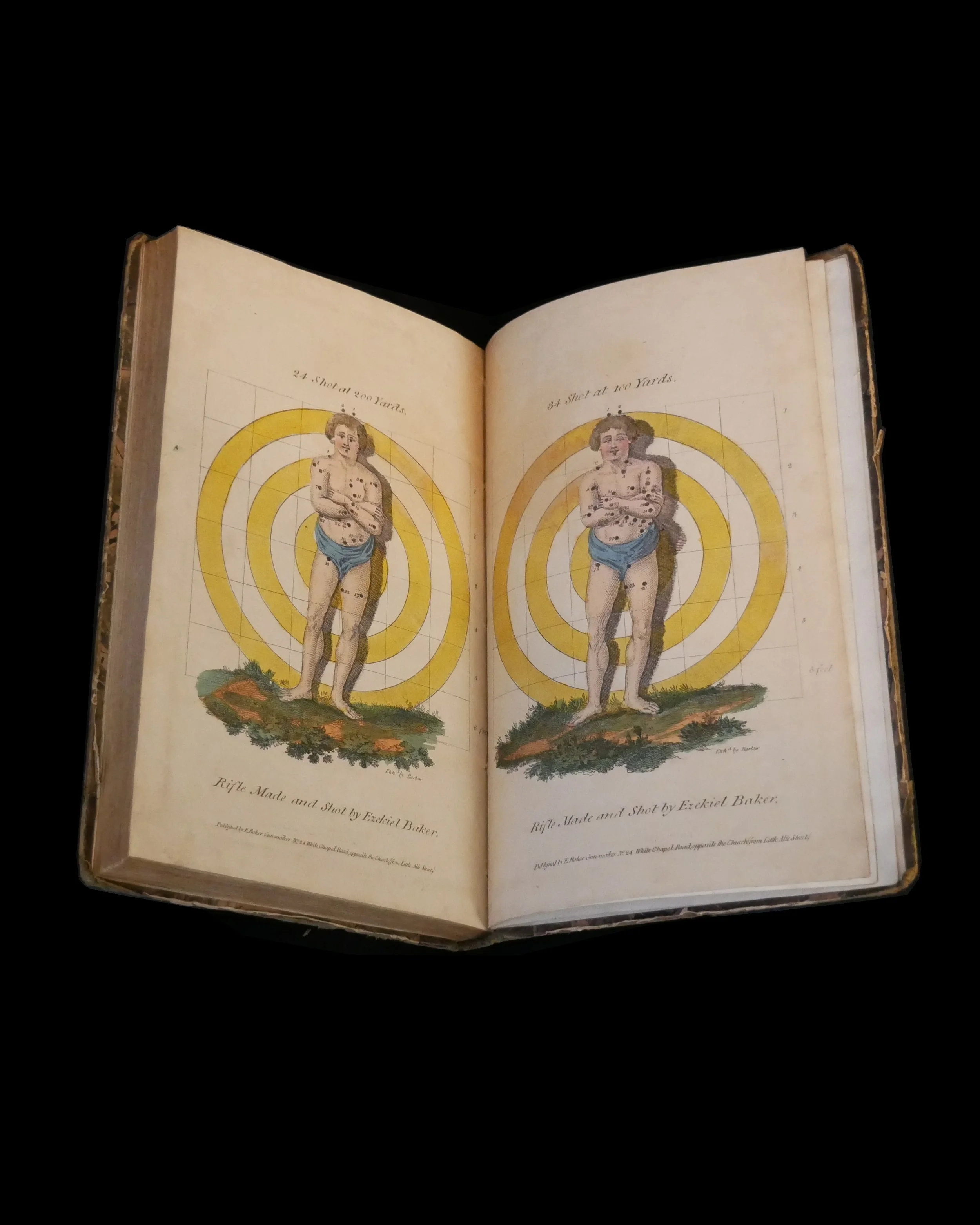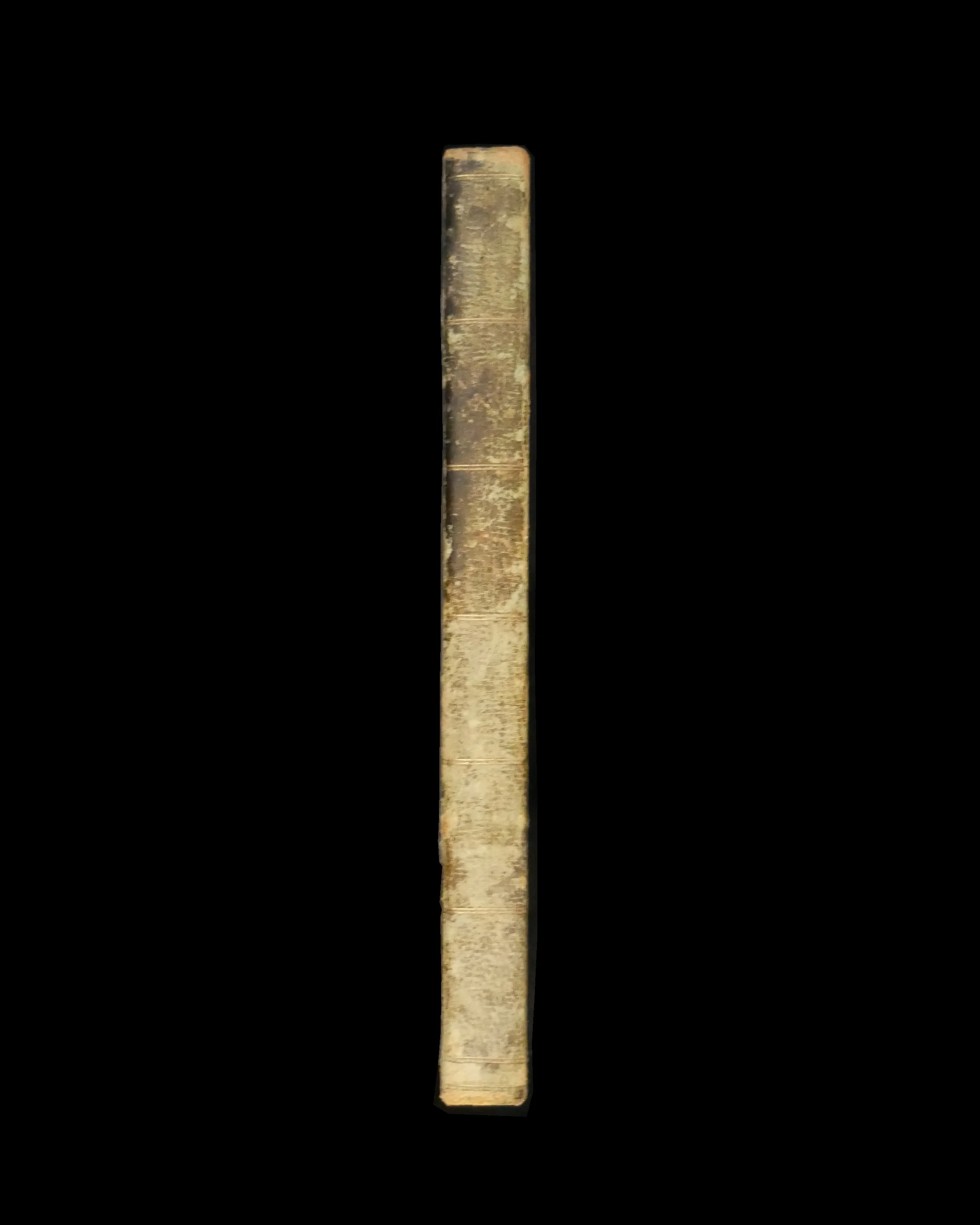Ezekiel Baker Remarks on Rifle Guns
Ezekiel Baker. Remarks on Rifle Guns; Being the Result of Fifty Years' Practice and Observation: With Specific Remarks on Fowling Pieces, the Percussion Lock, and Fire-Arms in General, To which are Subjoined Descriptions of a New Bullet Mould and Clipper, Various Improvements in Gun and Door Locks, and Spring Bolts; A Description of Fire-Arms Deposited in the Royal Arsenal at Woolwich, Including All the Improvements and Inventions for which Three Silver Medals Have Been Awarded by the Society of Arts. Together with Tables of Weights of Balls, Descriptive Plates, &c
Ninth edition
contemporary straight-grain morocco with origional marbled boards, title label lettered in gilt, pp. vi, [2], 244, illustrated with nine engraved plates (seven with hand-colouring) including frontispiece, plus 6-page engraved table, internally good with toning and some handling marks, very faint spotting in places, covers rubbed & worn but strong, London: Joseph Mallett, 1825
Baker writes about the early history of rifling, percussion locks, and casting lead balls for muskets and rifles. He also advises the reader on how to aim and use his rifle, as well as looking at fowling pieces and blunderbusses. He looks at the history of the early rifle, including a description of the early method of proofing barrels, and how to burst a blunderbuss. It also discusses the construction of firearms, with comments on stocking weapons and on the percussion lock, the important transitional firing method between flintlock and the firing pin.
Ezekiel Baker (1758–1836) was a master gunsmith from Whitechapel, London, who became known for his design of the Baker rifle in 1800. Baker also made several contributions to the development of gunnery. In 1821 he patented a new bullet mold and clipper. In 1822 he improved the jaws of the flint cock so that they would grip the flint more securely; and finally in 1824 he developed a lock that could be used for either flint or percussion with the proper adapters.
Ezekiel Baker. Remarks on Rifle Guns; Being the Result of Fifty Years' Practice and Observation: With Specific Remarks on Fowling Pieces, the Percussion Lock, and Fire-Arms in General, To which are Subjoined Descriptions of a New Bullet Mould and Clipper, Various Improvements in Gun and Door Locks, and Spring Bolts; A Description of Fire-Arms Deposited in the Royal Arsenal at Woolwich, Including All the Improvements and Inventions for which Three Silver Medals Have Been Awarded by the Society of Arts. Together with Tables of Weights of Balls, Descriptive Plates, &c
Ninth edition
contemporary straight-grain morocco with origional marbled boards, title label lettered in gilt, pp. vi, [2], 244, illustrated with nine engraved plates (seven with hand-colouring) including frontispiece, plus 6-page engraved table, internally good with toning and some handling marks, very faint spotting in places, covers rubbed & worn but strong, London: Joseph Mallett, 1825
Baker writes about the early history of rifling, percussion locks, and casting lead balls for muskets and rifles. He also advises the reader on how to aim and use his rifle, as well as looking at fowling pieces and blunderbusses. He looks at the history of the early rifle, including a description of the early method of proofing barrels, and how to burst a blunderbuss. It also discusses the construction of firearms, with comments on stocking weapons and on the percussion lock, the important transitional firing method between flintlock and the firing pin.
Ezekiel Baker (1758–1836) was a master gunsmith from Whitechapel, London, who became known for his design of the Baker rifle in 1800. Baker also made several contributions to the development of gunnery. In 1821 he patented a new bullet mold and clipper. In 1822 he improved the jaws of the flint cock so that they would grip the flint more securely; and finally in 1824 he developed a lock that could be used for either flint or percussion with the proper adapters.
Ezekiel Baker. Remarks on Rifle Guns; Being the Result of Fifty Years' Practice and Observation: With Specific Remarks on Fowling Pieces, the Percussion Lock, and Fire-Arms in General, To which are Subjoined Descriptions of a New Bullet Mould and Clipper, Various Improvements in Gun and Door Locks, and Spring Bolts; A Description of Fire-Arms Deposited in the Royal Arsenal at Woolwich, Including All the Improvements and Inventions for which Three Silver Medals Have Been Awarded by the Society of Arts. Together with Tables of Weights of Balls, Descriptive Plates, &c
Ninth edition
contemporary straight-grain morocco with origional marbled boards, title label lettered in gilt, pp. vi, [2], 244, illustrated with nine engraved plates (seven with hand-colouring) including frontispiece, plus 6-page engraved table, internally good with toning and some handling marks, very faint spotting in places, covers rubbed & worn but strong, London: Joseph Mallett, 1825
Baker writes about the early history of rifling, percussion locks, and casting lead balls for muskets and rifles. He also advises the reader on how to aim and use his rifle, as well as looking at fowling pieces and blunderbusses. He looks at the history of the early rifle, including a description of the early method of proofing barrels, and how to burst a blunderbuss. It also discusses the construction of firearms, with comments on stocking weapons and on the percussion lock, the important transitional firing method between flintlock and the firing pin.
Ezekiel Baker (1758–1836) was a master gunsmith from Whitechapel, London, who became known for his design of the Baker rifle in 1800. Baker also made several contributions to the development of gunnery. In 1821 he patented a new bullet mold and clipper. In 1822 he improved the jaws of the flint cock so that they would grip the flint more securely; and finally in 1824 he developed a lock that could be used for either flint or percussion with the proper adapters.

